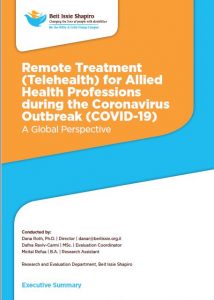The Coronavirus (COVID-19) pandemic erupted worldwide in 2020, with far-reaching consequences for all aspects of life, including health service provision.
Because of lockdown restrictions and limitations, healthcare professionals had to face a new reality, in which they became reliant on technology and digital communications to deliver services (“telehealth”). Allied health professionals found themselves confused and lacking the knowledge on how to provide remote treatment in an effective manner to their clients.
The main objective of this global study was to learn about the advantages and challenges allied health professionals around the world experienced providing remote treatments.
To read the report click the page Executive summary
 |
 |
 |
 |
Brennan, D. M., Georgeadis, A. C., Baron, C. R., and Barker, L. M. (2005). The Effect of Videoconference-Based Tele-rehabilitation on Story Retelling Performance by Brain-Injured Subjects and Its Implications for Remote Speech-Language Therapy. Telemedicine Journal and e-health, 10 (2).
Brennan, D., Tindall, L., Theodoros, D., Brown, J., Campell, M., Christiana, D., Smith, D., Cason, and J., Lee, A. (2010). A Blueprint for Telerehabilitation Guidelines. International Journal of Rehabilitation. 2(2). 31-34.
Cason, J. (2014). Telehealth: A Rapidly Developing Service Delivery Model for Occupational Therapy. International Journal of Rehabilitation. 6(1). 29-35.
Cason, J., and Brannon, J. (2011). Telehealth Regulatory and Legal Considerations: Frequently Asked Questions. International Journal of Rehabilitation. 3(2). 15-18.
Cottrell, M. A. and Russell, T. G. (2020). Telehealth for musculoskeletal physiotherapy. Musculoskeletal Science and practice, 48 (102193). 1-5.
DOI: 10.1016/j.msksp.2020.102193
Fridler, N., Rosen, K., Herzberg, O., Lev, A., Kaplan, D., Hildesheimer, M. and Shani, M. (2012). Tele-rehabilitation therapy vs. face-to-face therapy for aphasic patients. In eTELEMED 2012: The Fourth International Conference on eHealth, Telemedicine, and Social Medicine (pp. 18-23). Valencia: IARIA.
https://www.researchgate.net/publication/274713926_Tele-Rehabilitation_Therapy_vs_Face-to-Face_Therapy_for_Aphasic_Patients
Holland, A. (2013). Telehealth Reduces Hospital Admission Rates in Patients With COPD. Journal of Physiotherapy, 59(2). 129.
Hung, G. and Fong, K. (2019). Effects of tele-rehabilitation in occupational therapy practice: A systematic review. Hong Kong Journal of Occupational Therapy, 32(1) 3–21.
Jahromi, M.E., and Ahmadian, L. (2018). Evaluating satisfaction of patients with stutter regarding tele-speech therapy method and infrastructure. International Journal of Medical Informatics 115, 128-133.
Kruse, C.S., Krowski, N., Rodriguez, B., Tran, L., Vela, J., and Brooks, M. (2017). Telehealth and patient satisfaction: a systematic review and narrative analysis. BMJ Open Access Journals, 7(8). https://bmjopen.bmj.com/content/bmjopen/7/8/e016242.full.pdf
Levy, C.E., Silverman, E., Jia, H., Geiss, M., and Omura, D. (2015). Effects of physical therapy delivery by home video tele-rehabilitation on functional and health-related quality of life outcomes. Journal of Rehabilitation Research and Development; Washington, 52(3), 361-370.
Lopresti, E.F., Jinks, A., and Simpson, R.C. (2015). Consumer satisfaction with tele-rehabilitation service provision of alternative computer access and augmentative and alternative communication. International Journal of Tele-rehabilitation, l7(2), 3-14.
Mashima. P. A., Birkmire-Peters, D.P., Syms, M., Holtel, M.R., Burgess, L.P.A. and Peters, L.J. (2003). Voice Therapy using Telecommunication Technology 12(24). https://doi.org/10.1044/1058-0360(2003/089)
Odole, A.C. and Ojo, O.D. (2013). A Telephone-based Physiotherapy Intervention for Patients with Osteoarthritis of the Knee. International Journal of Rehabilitation, 5(2), 11-20.
Parvin, R. (2018). Perception of the patients and providers regarding telehealth service of disabled people's organizations (DPO) through center for the rehabilitation of paralyzed (CRP). (Doctoral dissertation, (Bangladesh Health Profession Institute, Faculty of Medicine, the University of Dhaka, Bangladesh: 2018-06-30).
Peretti, A., Amenta, F., Tayebati, S.K., Nittari, G., and Mahdi, S.S. (2017). Tele-rehabilitation: Review of the State-of-the-Art and Areas of application. JMIR Rehabilitation and Assistive Technologies, 4(2).
Roth, D., Raviv-Carmi, D., and Refua, M. (2020a). "Remote Treatment (Telehealth) for Allied Health Professions in Israel during the Coronavirus Outbreak (COVID-19)", Beit Issie Shapiro knowledge base (https://tinyurl.com/yxjca94z).
Roth, D., Raviv-Carmi, D., and Refua, M. (2020b). "Client experience of Remote Allied Health Treatment (Telehealth) during the Coronavirus outbreak (COVID-19) in Israel", Beit Issie Shapiro knowledge base (https://tinyurl.com/yyy6ad9g).
Russell, T., Buttrum, P., Wootton, R., and Gwendolen A. (2011). Internet-Based Outpatient Tele-rehabilitation for Patients Following Total Knee Arthroplasty - A Randomized Controlled Trial. Journal of Bone and Joint Surgery, 93 (2), 113-120.
Scheideman-Miller, C., Clark, P.G., Smeltzer, S.S., Carpenter, J., Hodge, B., and Prouty, D. (2002). Two-year results of a pilot study delivering speech therapy to students in a rural Oklahoma school by Telemedicine. In Proceedings of the 35th Annual Hawaii International Conference on System Sciences (9-pp). IEEE. https://ieeexplore.ieee.org/document/994136
Tindall, L.R., and Huebner, R.A. (2009). The Impact of an Application of Tele-rehabilitation Technology on Caregiver Burden. International Journal of Rehabilitation. 1(1). 3-8.
Truter, P., Russell, T., and Fary, R. (2014). The Validity of Physical Therapy Assessment of Low Back Pain by Tele-rehabilitation in a Clinical Setting. Telemed J E Health, 20(2). 161-167. Retrieved from: https://pubmed.ncbi.nlm.nih.gov/24283249/#affiliation-1
Tousignant, M., Boissy, P., Moffet, H., Corriveau, H., Cabana, F., Marquis, F., and Simard, J. (2011). Patients' Satisfaction of Healthcare Services and Perception with In-Home Tele-rehabilitation and Physiotherapists' Satisfaction toward Technology for Post-Knee Arthroplasty: An Embedded Study in a Randomized Trial. Telemedicine and e-Health, 17(5), 376-382. https://www.liebertpub.com/doi/full/10.1089/tmj.2010.0198
Tousignant, M., Macoir, J., Martel-Sauvageau, V., Boissy, P., Corriveau H., Gosselin, S., Dubois, M.F., Tousignant, M., and Page, C. (2018). Satisfaction with in-home speech rehabilitation in chronic post-stroke aphasia: an exploratory analysis. Journal of the international society of telemedicine and e-health, 6, e11-1. https://journals.ukzn.ac.za/index.php/JISfTeH/article/view/362/937
Whitten, P. S. and Mair, F. (2000). Telemedicine and Patient Satisfaction: Current Status and Future Directions. Telemedicine Journal and e-health, 6 (4), 417-423.
WHO, 2016, https://www.who.int/gho/goe/telehealth
World Bank Internet Site, (2020) https://datahelpdesk.worldbank.org/knowledgebase/articles/906519-world-bank-country-and-lending-groups
All disabilities
Technology
Therapeutic Methods
General public, Professionals